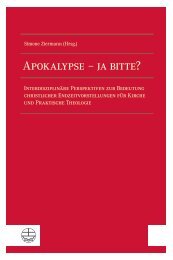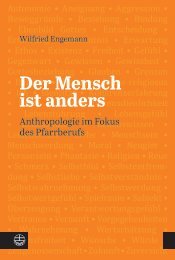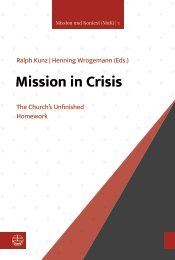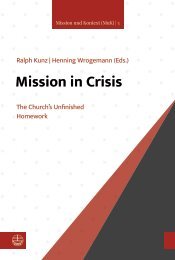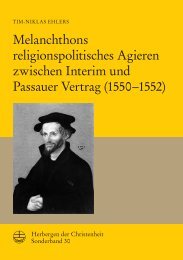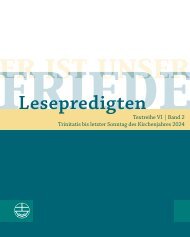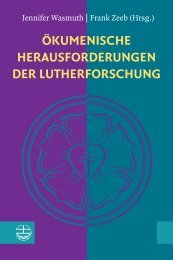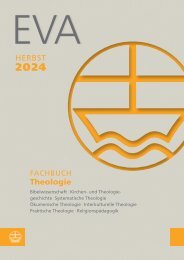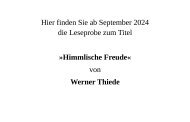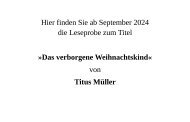Phillip A. Davis, Jr. | Daniel Lanzinger | Matthew Ryan Robinson (Eds.): What Does Theology Do, Actually? (Leseprobe)
You also want an ePaper? Increase the reach of your titles
YUMPU automatically turns print PDFs into web optimized ePapers that Google loves.
The Catholic Understanding of Scripture 137<br />
mately only understand the Bible through participatory observation. We are<br />
caught in this hermeneutical circle --- and this is true for all forms of understanding.<br />
4<br />
Antique philosophical schools likewise saw themselves as ways of life.<br />
Their teachings could not be grasped from a distance and from mere observation;<br />
they had to be lived. Likewise, the Bible is an expression of a way of life. It<br />
wishes to lead us to a form of spiritual practice or more precisely: to a form of<br />
social practice. The principle of participatory observation is relevant in some<br />
form for any kind of understanding. Buddhist texts, for instance, can only be<br />
understood through practice of the same. They are an expression of a practical<br />
form of life. Verbum <strong>Do</strong>mini expresses it as follows: ‘‘Here we see the reason why<br />
an authentic process of interpretation is never purely an intellectual process but<br />
also a lived one, demanding full engagement in the life of the Church, which is<br />
life ‘according to the Spirit’ (Gal 5:16)’’ (38). The first and foundational principle<br />
of Catholic biblical hermeneutics therefore would be: ‘‘The Holy Spirit, who gives<br />
life to the Church, enables us to interpret the Scriptures authoritatively. The<br />
Bible is the Church’s book, and its essential place in the Church’s life gives rise<br />
to its genuine interpretation’’ (29).<br />
2. The Council’s Biblical Hermeneutic: A Directive to<br />
be Appropriated<br />
As was said previously, the Constitution on Divine Revelation of the Second<br />
Vatican Council, Dei Verbum, which presented the fundamentals of biblical interpretation<br />
in the Church, brought with it full acceptance of historical-critical<br />
exegesis in the Catholic Church. The classical principles of Scriptural hermeneutics<br />
that were inherited from the Early Church, however, were not thereby relinquished.<br />
They were called to mind and, to a certain extent, simply placed alongside<br />
the model of modern Scriptural interpretation, remaining detached from the<br />
latter. Yet, post-conciliar reception of Dei Verbum almost exclusively focused on<br />
the historical-critical aspect of Scriptural interpretation, whereas traditional<br />
principles such as the unity of Scripture, the multiple senses of Scripture, and<br />
the orientation according to the regula fidei largely fell into oblivion. As a theologian,<br />
Joseph Ratzinger had often criticized a one-sided reception of Dei Verbum. 5<br />
The Apostolic Exhortation Verbum <strong>Do</strong>mini reminds us of this in the following<br />
words: ‘‘On the one hand, the Council emphasizes the study of literary genres<br />
4<br />
Cf. Ludger Schwienhorst-Schönberger, ‘‘Kontemplatives Schriftverständnis --- Zur Wechselbeziehung<br />
von kontemplativer Übung und Schriftverständnis,’’ Studies in Spirituality<br />
17 (2007): 115---25.<br />
5<br />
Cf. Ludger Schwienhorst-Schönberger, ‘‘Zwei antagonistische Modelle der Schriftauslegung<br />
in Dei Verbum?,’’ in Erinnerung an die Zukunft: Das Zweite Vatikanische Konzil, ed.<br />
Jan-Heiner Tück (Freiburg: Herder, 2013), 517---29.





